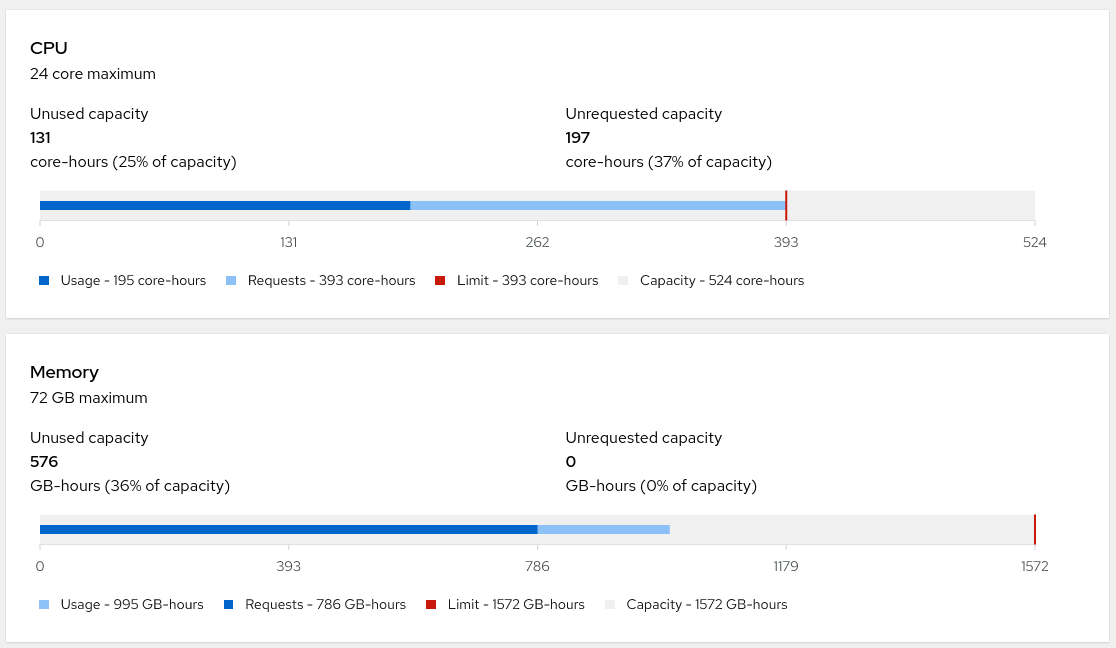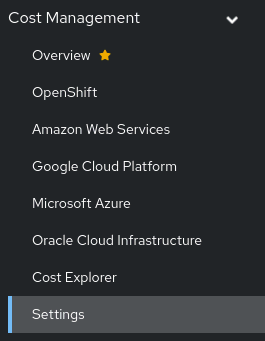It was summer in the Northern Hemisphere, and many people took some time off for vacation, but the Red Hat Insights cost management team kept working hard to make the product better. Let's talk about what's new in our cloud and on-premise cost management tool, which comes at no additional cost since it is included in your Red Hat subscription.
Report vCPU count, RAM and storage capacity
Insights cost management comes with batteries included: When you register your Red Hat OpenShift clusters and connect your cloud accounts (if your clusters run on the cloud), we will automatically distribute your costs according to smart defaults, e.g., cost distribution based on effective CPU usage and, in the default configuration, no distribution of overhead costs.
You can customize this by defining a cloud cost model in the Insights cost management UI and an OpenShift cost model, which will open advanced capabilities such as cost distribution based on requested, used, or effective CPU or RAM usage, distributing the overhead costs of Kubernetes/OpenShift control plane, etc. That's for the costs that the cost management service is aware of.
Typical IT workloads and departments incur additional costs: Subscriptions, external services with variable costs (e.g., using services like Google Maps), outsourcing, cost of the IT employees, etc. Distributing these costs is individual based on your unique needs. One popular way is to redistribute and align them with OpenShift workloads, which requires knowing how many CPU cores and memory the OpenShift nodes and clusters have and have used so those numbers can be extended for other costs.
It is possible to approximate these values by taking the CPU core-hours and RAM GB-hours and dividing them by the number of hours in the month ("CPU_core_hours / #_hours_in_month" or "RAM_GB_hours / #_hours_in_month"), but if autoscalers are used, those numbers would not be right.
In the latest release of Insights cost management, we are reporting the number of CPU cores and RAM. We are also informing you about the maximum value since autoscalers may have changed the capacity at any given time during the billing cycle.

Settings page: Redesigned and moved
For a long time, the Red Hat Insights cost management settings page lived within the Hybrid Cloud Console settings. While this looks correct, it was sometimes hard for users to discover the settings, and therefore, many users were operating with only the default enabled tags (cloud but not OpenShift), currency (USD), etc.
To accommodate cost management users who want cost reports based on tags, use different currencies, or even want to see the AWS costs in a different way than the default (e.g., amortized instead of unblended), we have moved the settings page inside cost management for easier discoverability and enhanced the "Tags and labels" and "Cost categories" subpages. The cost models page has been moved inside the new settings page too.
While moving the settings page inside cost management, we have also relaxed the permissions - only "Cost Price List Administrator" permissions are now needed. In the past, modifying the cost management settings required Hybrid Cloud Console-wide "Organization Administrator" permissions, which made some customers uncomfortable because it gave tag managers too much control and visibility.


Optionally show overhead costs
When running workloads on OpenShift, users are interested in the cost of the workload. They also need to consider the cost of the OpenShift control plane and the cost of the unallocated capacity (also referred to as "overhead costs").
A previous release of Insights cost management enhanced cost models and started reporting those costs. With this new release, we are allowing you to not only distribute the costs, but also dynamically switch to viewing costs with or without overhead cost distribution so you better understand the distribution of your spending.

Large customer data pipeline
Many organizations that use Insights cost management are big customers, but no matter your infrastructure size, we've got you covered.
The latest release of Insights cost management implements separate pipelines for different customer sizes so that cost management processes data from all customers and is responsible, even if some large customers decide to send data for a whole month for a thousand clusters at the same time.
You make Insights cost management better
All of the above features resulted from customer requests for enhancements, which were accepted and prioritized in our backlog. Every bit of functionality described here is available through the web UI and the cost management API (in fact, our UI is built on top of the same API users have access to).
Are you missing something in Insights cost management? Check our backlog in Jira (it's public!) and join our public announcement mailing list. If you can’t find that one feature or enhancement you really need, get in touch with your Red Hat account manager or with Red Hat Support to open a new request for enhancement.
Sobre o autor
Pau Garcia Quiles joined Red Hat in 2021 as Principal Product Manager. He has 20 years of experience in IT in various roles, both as a vendor and as a customer, systems administrator, software developer and project manager. He has been involved in open source for more than 15 years, most notably as a Debian maintainer, KDE developer and Uyuni developer.
Navegue por canal
Automação
Últimas novidades em automação de TI para empresas de tecnologia, equipes e ambientes
Inteligência artificial
Descubra as atualizações nas plataformas que proporcionam aos clientes executar suas cargas de trabalho de IA em qualquer ambiente
Nuvem híbrida aberta
Veja como construímos um futuro mais flexível com a nuvem híbrida
Segurança
Veja as últimas novidades sobre como reduzimos riscos em ambientes e tecnologias
Edge computing
Saiba quais são as atualizações nas plataformas que simplificam as operações na borda
Infraestrutura
Saiba o que há de mais recente na plataforma Linux empresarial líder mundial
Aplicações
Conheça nossas soluções desenvolvidas para ajudar você a superar os desafios mais complexos de aplicações
Programas originais
Veja as histórias divertidas de criadores e líderes em tecnologia empresarial
Produtos
- Red Hat Enterprise Linux
- Red Hat OpenShift
- Red Hat Ansible Automation Platform
- Red Hat Cloud Services
- Veja todos os produtos
Ferramentas
- Treinamento e certificação
- Minha conta
- Suporte ao cliente
- Recursos para desenvolvedores
- Encontre um parceiro
- Red Hat Ecosystem Catalog
- Calculadora de valor Red Hat
- Documentação
Experimente, compre, venda
Comunicação
- Contate o setor de vendas
- Fale com o Atendimento ao Cliente
- Contate o setor de treinamento
- Redes sociais
Sobre a Red Hat
A Red Hat é a líder mundial em soluções empresariais open source como Linux, nuvem, containers e Kubernetes. Fornecemos soluções robustas que facilitam o trabalho em diversas plataformas e ambientes, do datacenter principal até a borda da rede.
Selecione um idioma
Red Hat legal and privacy links
- Sobre a Red Hat
- Oportunidades de emprego
- Eventos
- Escritórios
- Fale com a Red Hat
- Blog da Red Hat
- Diversidade, equidade e inclusão
- Cool Stuff Store
- Red Hat Summit

